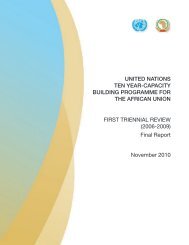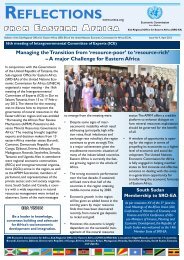Tool kit for Gender and Agriculture - Economic Commission for Africa
Tool kit for Gender and Agriculture - Economic Commission for Africa
Tool kit for Gender and Agriculture - Economic Commission for Africa
You also want an ePaper? Increase the reach of your titles
YUMPU automatically turns print PDFs into web optimized ePapers that Google loves.
40<br />
Improving <strong>Agriculture</strong> through <strong>Gender</strong> Analysis<br />
Source: J. Murphy, 1994, <strong>Gender</strong> Issues in World Bank Lending, World Bank, Operations<br />
Evaluation Department, Washington, D.C.<br />
Box 12: Thematic Supervision in <strong>Agriculture</strong> Projects in Yemen<br />
<strong>Agriculture</strong>, the predominant sector in the Yemeni labor <strong>for</strong>ce, is estimated to employ<br />
94 percent of female <strong>and</strong> 70 percent of men workers. <strong>Gender</strong> segregation has traditionally<br />
made it difficult <strong>for</strong> women to gain access to agricultural extension that is<br />
provided by men. To address the difficulties in implementing the first projects concerned<br />
with women’s work in agriculture in Yemen, the Bank instated thematic WID<br />
supervision by experts on women in agricultural development. The supervision drew<br />
several lessons applicable to all the projects:<br />
• To reach a critical number of women extension agents, providing more training<br />
programs <strong>and</strong> recruiting, training, <strong>and</strong> placing more women will be necessary.<br />
• To maximize the potential of Yemeni women as agents of agricultural development,<br />
extension must focus directly on agricultural priorities by developing clearly<br />
focused extension messages <strong>and</strong> field support programs.<br />
• Agricultural research needs to be linked specifically to the needs of women through<br />
a of a two-way process of communication.<br />
• Funds <strong>and</strong> equipment must be earmarked to ensure that women extension agents<br />
are able to work effectively.<br />
• Extension activities <strong>for</strong> women must be integrated into a nationwide agricultural<br />
strategy to take into account the gender implications of technical modernization,<br />
increases in productivity, <strong>and</strong> agricultural growth.<br />
Implementation completion reports, impact studies, <strong>and</strong> evaluation reports specifically<br />
need to identify gender-differentiated results <strong>and</strong> draw out the lessons learned.<br />
They should also describe <strong>and</strong> evaluate special ef<strong>for</strong>ts used to increase the participation<br />
of women (or female-headed households or any other special social group). Evaluations<br />
need not be just within agriculture but can be in the <strong>for</strong>m of cross-sectoral gender<br />
implementation reviews. 8<br />
Such a review is currently being undertaken <strong>for</strong> Yemen<br />
Country Operations. Drawing on data collected from missions, UNESCO <strong>and</strong> UNICEF<br />
sources, <strong>and</strong> household <strong>and</strong> 1992 demographic <strong>and</strong> health surveys the review will describe<br />
persistent gender disparities, discuss their causes, <strong>and</strong> make recommendations to<br />
help reduce them.<br />
a. Strategies to Promote Attention to <strong>Gender</strong> During Monitoring <strong>and</strong> Evaluation<br />
8 J. Murphy, 1994, <strong>Gender</strong> Issues in the World Bank Lending, World Bank, Operations Evaluation De-<br />
partment.







